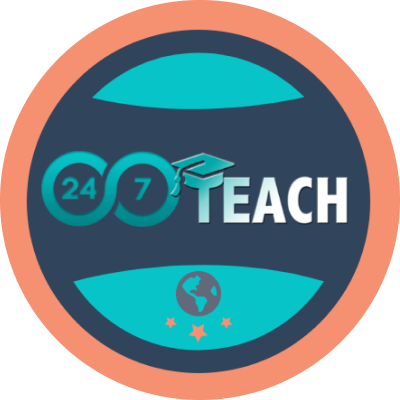Lesson 1: Introduction to Rhetoric
Prefer to listen to directions? Use the audio file below.
Lesson 1 Scenario:
Imagine yourself in the following scenario:
You are a student pursuing a career in aviation. You have almost completed your technical training and will soon enter your on-the-job training. However, during a training simulation, you had a miscommunication with your team that could have led to unsafe conditions for the aircraft and passengers. You realize that while you have learned the technical skills necessary for the job, you haven't had much experience with the communication skills required for the position. You speak with your supervisor, who advises that you take an English 101 course hosted by 24/7 Teach to help you become an effective professional communicator.
Your first step is to learn about rhetorical situations so that you can effectively analyze the context, purpose, and audience of your communication in different situations.
You are excited to see how understanding rhetorical situation can help you to anticipate and respond to potential communication challenges that might arise on the job, including how to communicate clearly during emergency situations, how to deescalate tense or stressful situations, how to identify cultural or language barriers that could impact communication, and how to adapt your communication style to overcome these challenges.
Lesson 1 - Objectives and Directions:
Objectives: After successfully completing this lesson, you will be able to:
Identify and define the key components of a rhetorical situation in two different texts. These components include the speaker, audience, message, purpose, and context.
Compare and contrast the rhetorical situations of two different texts. This includes identifying similarities and differences in how each text is constructed to achieve its purpose and affect its intended audience.
Apply critical thinking skills to analyze how rhetorical situations influence the effectiveness of the texts.
Connect your understanding of rhetorical situations to your personal experiences by reflecting on instances where you have been part of a rhetorical situation – as a speaker, listener, or observer.
Lesson 1 - Vocabulary:
Click on the button below to preview the essential vocabulary for this lesson. Once you complete the readings, you will need to correctly use at least 3 vocabulary words in your assessment or discussion responses, using the following criteria:
Include 2 vocabulary words in any of your written responses (assessment or discussion)
Include 1 vocabulary word in your audio or video response
In the assessment below, list the 3 vocabulary words you have chosen to use in your responses
Lesson 1 - Presentation and Readings:
Review the following Presentation: (Click here if you wish to download the presentation)
Your required readings for this unit will include chapters from the textbook, Everyone’s an Author, and supplemental excerpts, “The First Air Mail,” and “The St. Louis-Chicago Mail.”
Click on each title below to read the text introductions and to access the links to the reading. Take notes as you read.
-
Welcome to Chapter 1, where we explore the power of rhetoric - the art of persuasion - as a means to avoid conflict and confusion. The careful use of language is a vital skill that we can all develop to ensure that our messages are conveyed effectively and ethically. In this chapter, you will learn how to think and act rhetorically, starting with the essential habit of listening and understanding before forming opinions. We will see how this way of thinking can be used to negotiate effectively, as illustrated by a case study of students fighting for workers' rights on their campuses.
But the importance of rhetorical thinking extends far beyond negotiation and advocacy. As we delve deeper, we will also discover how it can be used to convey messages to specific audiences, how it can build credibility, and how the use of imagination and intuition can generate new insights and ideas. So let's explore the concepts covered in Chapter 1 to understand better how we can harness the power of rhetoric to make our voices heard and create a better world.
-
Have you ever struggled with communicating your ideas effectively in writing or public speaking? Do you often wonder why your message doesn't seem to resonate with your intended audience? The key may lie in understanding the concept of rhetorical situations. I
In Chapter 2 of "Everyone's an Author," we explore the importance of analyzing the context, purpose, audience, genre, medium, and design of each piece of writing or speech. By doing so, you can strategically tailor your message to achieve the desired impact. The practical prompts provided in this chapter will help you analyze your rhetorical situation and make informed choices about your writing. Join us as we dive into the world of rhetoric and learn how to create more compelling and effective written works and speeches.
-
Welcome to Chapter 3 of "Everyone's an Author." In today's world, we are bombarded with information from various sources. Social media, news articles, and even advertisements demand our attention, making it challenging to discern what is relevant and valuable. As readers, we need to approach texts strategically, engage with them actively, and apply critical thinking skills to make sense of the information presented to us. In this chapter, we will explore the importance of reading rhetorically and the importance of “infotention” and how it can help us navigate the digital age effectively.
We will delve into tips and techniques for effective reading, including previewing, annotating, and summarizing texts. Furthermore, we will examine how reading is evolving in the digital age and how we can adapt our reading strategies to ensure we are getting the most out of the information we encounter. By the end of this chapter, you will have the tools to read more critically, effectively, and purposefully in today's information age.
-
Welcome to Chapter 4 of "Everyone's an Author." Have you ever struggled to write a paper that meets the standards of your teacher or felt lost when it comes to the conventions of academic writing? If so, you're not alone.
Academic writing is an essential part of the academic experience, but it can be challenging to navigate for both native and non-native speakers of English. In this chapter, we will explore the demands of academic writing and the expectations of academic writing that students need to learn to "talk the talk" and join academic conversations. We'll also discuss the characteristics of academic writing and offer tips on how to overcome the challenges you may encounter.
By the end of this chapter, you'll have a deeper understanding of academic writing and the skills to become a more effective academic writer. So let's get started!
-
Supplemental Reading 1 - Excerpt from The Story of American Aviation by James G. Ray: This text provides a brief background on the United States beginning their air mail service.
Directions: Read the section called “The First Air Mail” on page 38. Click on the link below to access the full text.
Link: The First Air Mail
Supplemental Reading 2 - Excerpt from The Spirit of St Louis by Charles Lindbergh: This text describes the determination of a US airman to deliver the mail on time despite major challenges.
Directions: Read the first 7 pages of chapter 1, “The St. Louis-Chicago Mail.” Click on the link below to access the full text.
Link: The Spirit of St Louis
Lesson 1 - Journal Activity:
Write a journal entry responding to ONE of the following prompts. Click on the button below to submit your response.
Prompt A: Imagine you had the chance to meet and talk with the narrator in the excerpt, “The St. Louis-Chicago Mail.” What would you say to him?
Prompt B: What are your current strengths as a professional communicator in English? How do you hope to grow?
Lesson 1 - Assessment:
Directions:
Click on the button below to submit your responses to the following questions. Write your responses in complete sentences using academic language.
(For question 3, submit an audio recording*. See directions on how to record and submit your audio below.)
You may use the conversation starters found in the lesson directions to support your answers.
Questions:
What is rhetorical listening, and why is it important?
Why is it important to annotate texts? What are some effective annotation techniques?
AUDIO SUBMISSION*: Name at least two expectations of college writing.
List the 3 vocabulary words you have chosen to use in your assessment or discussion responses.
Participate in our discussion below
↓
Participate in our discussion below ↓
Lesson 1 - Discussion Activity:
Directions:
Post your responses to the questions in the comments section below. (For question 3, submit a video recording*. See directions on how to record and submit your video below.)
Respond to 2 peers. Be specific about what you agree with and what you disagree with. Be respectful in your responses.
Write your responses in complete sentences using academic language.
You may use the conversation starters found in the lesson directions to support your answers.
Discussion Questions:
Provide an example of how your own perspective or cultural background has influenced your understanding of a particular piece of writing.
Compare and contrast the rhetorical situation of "The Spirit of St. Louis" and "The First Air Mail." How do the audiences, purposes, and contexts of these two pieces of writing differ? What impact does this have on the way the messages are communicated?
VIDEO SUBMISSION*: Think about a time when you had to communicate a message to a specific audience. Then, record a video response to the following questions.
What was the message and audience?
What factors did you consider in order to effectively explain your message to that audience?
How would you have explained your message differently if you were communicating to a different audience?























